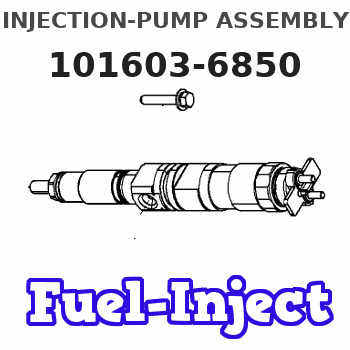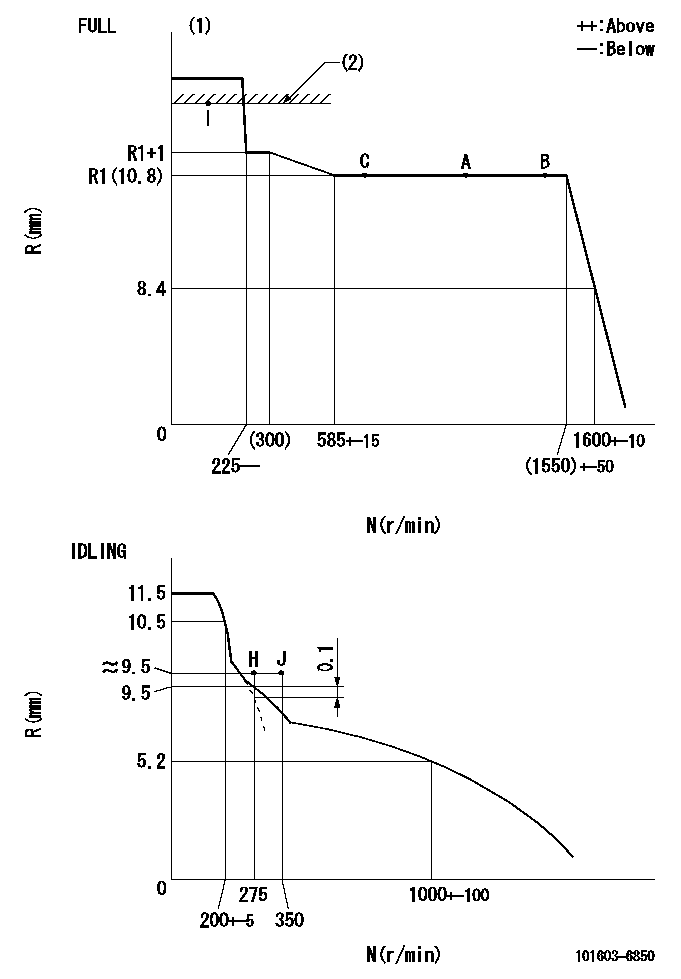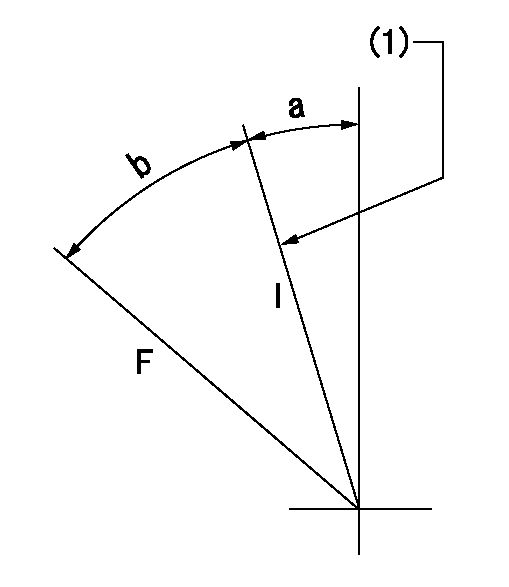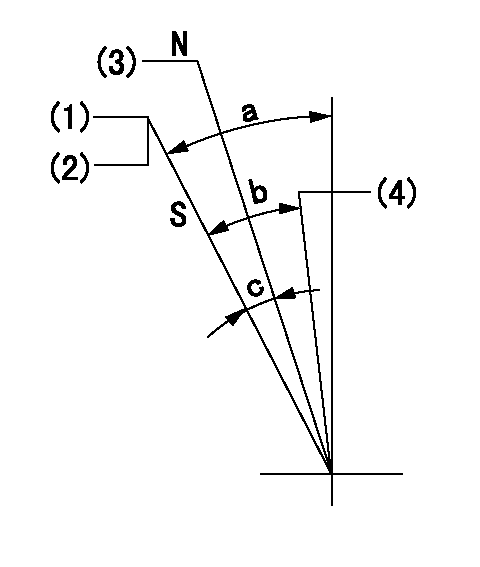Information injection-pump assembly
ZEXEL
101603-6850
1016036850
MITSUBISHI
ME035345
me035345

Rating:
Service parts 101603-6850 INJECTION-PUMP ASSEMBLY:
1.
_
6.
COUPLING PLATE
7.
COUPLING PLATE
8.
_
9.
_
11.
Nozzle and Holder
ME035655
12.
Open Pre:MPa(Kqf/cm2)
21.6(220)
15.
NOZZLE SET
Include in #1:
101603-6850
as INJECTION-PUMP ASSEMBLY
Include in #2:
104741-1744
as _
Cross reference number
ZEXEL
101603-6850
1016036850
MITSUBISHI
ME035345
me035345
Zexel num
Bosch num
Firm num
Name
Calibration Data:
Adjustment conditions
Test oil
1404 Test oil ISO4113 or {SAEJ967d}
1404 Test oil ISO4113 or {SAEJ967d}
Test oil temperature
degC
40
40
45
Nozzle and nozzle holder
105780-8140
Bosch type code
EF8511/9A
Nozzle
105780-0000
Bosch type code
DN12SD12T
Nozzle holder
105780-2080
Bosch type code
EF8511/9
Opening pressure
MPa
17.2
Opening pressure
kgf/cm2
175
Injection pipe
Outer diameter - inner diameter - length (mm) mm 6-2-600
Outer diameter - inner diameter - length (mm) mm 6-2-600
Overflow valve
131424-5520
Overflow valve opening pressure
kPa
255
221
289
Overflow valve opening pressure
kgf/cm2
2.6
2.25
2.95
Tester oil delivery pressure
kPa
157
157
157
Tester oil delivery pressure
kgf/cm2
1.6
1.6
1.6
Direction of rotation (viewed from drive side)
Left L
Left L
Injection timing adjustment
Direction of rotation (viewed from drive side)
Left L
Left L
Injection order
1-5-3-6-
2-4
Pre-stroke
mm
3.3
3.25
3.35
Beginning of injection position
Governor side NO.1
Governor side NO.1
Difference between angles 1
Cal 1-5 deg. 60 59.5 60.5
Cal 1-5 deg. 60 59.5 60.5
Difference between angles 2
Cal 1-3 deg. 120 119.5 120.5
Cal 1-3 deg. 120 119.5 120.5
Difference between angles 3
Cal 1-6 deg. 180 179.5 180.5
Cal 1-6 deg. 180 179.5 180.5
Difference between angles 4
Cyl.1-2 deg. 240 239.5 240.5
Cyl.1-2 deg. 240 239.5 240.5
Difference between angles 5
Cal 1-4 deg. 300 299.5 300.5
Cal 1-4 deg. 300 299.5 300.5
Injection quantity adjustment
Adjusting point
-
Rack position
10.8
Pump speed
r/min
850
850
850
Each cylinder's injection qty
mm3/st.
65
63
67
Basic
*
Fixing the rack
*
Standard for adjustment of the maximum variation between cylinders
*
Injection quantity adjustment_02
Adjusting point
H
Rack position
9.5+-0.5
Pump speed
r/min
275
275
275
Each cylinder's injection qty
mm3/st.
10.5
9
12
Fixing the rack
*
Standard for adjustment of the maximum variation between cylinders
*
Injection quantity adjustment_03
Adjusting point
A
Rack position
R1(10.8)
Pump speed
r/min
850
850
850
Average injection quantity
mm3/st.
65
64
66
Basic
*
Fixing the lever
*
Injection quantity adjustment_04
Adjusting point
B
Rack position
R1(10.8)
Pump speed
r/min
1450
1450
1450
Average injection quantity
mm3/st.
77.5
75.5
79.5
Fixing the lever
*
Injection quantity adjustment_05
Adjusting point
C
Rack position
R1(10.8)
Pump speed
r/min
600
600
600
Average injection quantity
mm3/st.
51.5
49.5
53.5
Fixing the lever
*
Injection quantity adjustment_06
Adjusting point
I
Rack position
14.1+-0.
5
Pump speed
r/min
100
100
100
Average injection quantity
mm3/st.
90
70
110
Fixing the lever
*
Rack limit
*
Timer adjustment
Pump speed
r/min
1250--
Advance angle
deg.
0
0
0
Remarks
Start
Start
Timer adjustment_02
Pump speed
r/min
1200
Advance angle
deg.
0.5
Timer adjustment_03
Pump speed
r/min
1350
Advance angle
deg.
2.4
1.9
2.9
Timer adjustment_04
Pump speed
r/min
1500
Advance angle
deg.
5
4.5
5.5
Remarks
Finish
Finish
Test data Ex:
Governor adjustment

N:Pump speed
R:Rack position (mm)
(1)Torque cam stamping: T1
(2)RACK LIMIT
----------
T1=A70
----------
----------
T1=A70
----------
Speed control lever angle

F:Full speed
I:Idle
(1)Stopper bolt set position 'H'
----------
----------
a=10deg+-5deg b=42deg+-3deg
----------
----------
a=10deg+-5deg b=42deg+-3deg
Stop lever angle

N:Engine manufacturer's normal use
S:Stop the pump.
(1)Set the stopper bolt at speed = rated point and rack position = aa and confirm non-injection (non-injection rack position).
(2)After setting the stopper bolt , confirm non-injection at pump speed bb. Rack position = cc (non-injection rack position).
(3)Rack position = approximately dd
(4)Free (at shipping)
----------
aa=7.2mm bb=275r/min cc=8.2mm dd=15mm
----------
a=41deg+-5deg b=(29.5deg) c=15.5deg+-3deg
----------
aa=7.2mm bb=275r/min cc=8.2mm dd=15mm
----------
a=41deg+-5deg b=(29.5deg) c=15.5deg+-3deg
0000001501 MICRO SWITCH
Adjustment of the micro-switch
Adjust the bolt to obtain the following lever position when the micro-switch is ON.
(1)Speed N1
(2)Rack position Ra
----------
N1=400+-5r/min Ra=9.2mm
----------
----------
N1=400+-5r/min Ra=9.2mm
----------
Timing setting

(1)Pump vertical direction
(2)Position of timer's tooth at No 1 cylinder's beginning of injection
(3)B.T.D.C.: aa
(4)-
----------
aa=13deg
----------
a=(0deg)
----------
aa=13deg
----------
a=(0deg)
Information:
To receive satisfactory engine performance with maximum fuel economy and service life, the following engine operation instructions must be applied. In addition, it is necessary to also apply the recommendations of the vehicle manufacturer as well as the every day rules of good driving.After the engine starts, reduce engine RPM to low idle with no load. When normal oil pressure is reached, operate the engine at low load for 5 minutes before applying full load.Stop Engine At Once If Any Part Fails
Almost all failures give a warning to the operator before the part completely fails. If the operator is alert and heeds the warnings, further damage may not happen. A few of the warning signs are: abnormal gauge readings, abnormal fluid levels, fluid leaks, unusual engine noises and excessive smoke. Do not operate an engine if any sign of part failure is present, only a few seconds can ruin an entire engine.Start vehicle in motion by utilizing the lowest gear speed in the transmission that will enable the engine to easily start the load without slipping the clutch. Accelerate smoothly and evenly until the engine speed reaches approximately 100% of rated RPM. Rapid depression of accelerator will result in undesirable heavy exhaust smoke and high fuel consumption with no increase in vehicle performance. Upshift to the next higher gear speed. If properly done, the engine speed will be above approximately 80% of rated RPM when the load is applied. For best performance do not skip gears. Engine speed should not be permitted to drop appreciably below 80% of rated RPM, to avoid a lugging condition.Caterpillar engines have good lugging characteristics; however, operating in a lug condition for extended periods of time should be avoided as it causes exhaust temperatures to rise and also results in high fuel consumption. A lug condition exists when an increase in engine speed cannot be achieved with an increase in accelerator pedal position, or when engine speed decreases with the accelerator pedal in its maximum position. A lug condition can exist at any engine speed below full load speed. Continue to make successive upshifts through each gear speed in the transmission until cruising speed is reached. In each gear speed, accelerate smoothly to an engine speed of approximately 100% of rated RPM before upshifting to the next gear. For highway cruising, maintain the engine speed between approximately 80% and 100% of rated RPM. Operating in this range will give maximum fuel economy.When going up a grade and the engine speed drops to below approximately 80% of rated RPM, downshift successively until a gear speed is reached that will enable the engine to pull the load without operating in a lug condition. When pulling a long grade, such as encountered in mountain driving, make additional downshifts of one or two gears immediately prior to reaching the summit. This will allow the engine to cool more slowly than if the load on the engine is suddenly changed from a full load condition going uphill to
Almost all failures give a warning to the operator before the part completely fails. If the operator is alert and heeds the warnings, further damage may not happen. A few of the warning signs are: abnormal gauge readings, abnormal fluid levels, fluid leaks, unusual engine noises and excessive smoke. Do not operate an engine if any sign of part failure is present, only a few seconds can ruin an entire engine.Start vehicle in motion by utilizing the lowest gear speed in the transmission that will enable the engine to easily start the load without slipping the clutch. Accelerate smoothly and evenly until the engine speed reaches approximately 100% of rated RPM. Rapid depression of accelerator will result in undesirable heavy exhaust smoke and high fuel consumption with no increase in vehicle performance. Upshift to the next higher gear speed. If properly done, the engine speed will be above approximately 80% of rated RPM when the load is applied. For best performance do not skip gears. Engine speed should not be permitted to drop appreciably below 80% of rated RPM, to avoid a lugging condition.Caterpillar engines have good lugging characteristics; however, operating in a lug condition for extended periods of time should be avoided as it causes exhaust temperatures to rise and also results in high fuel consumption. A lug condition exists when an increase in engine speed cannot be achieved with an increase in accelerator pedal position, or when engine speed decreases with the accelerator pedal in its maximum position. A lug condition can exist at any engine speed below full load speed. Continue to make successive upshifts through each gear speed in the transmission until cruising speed is reached. In each gear speed, accelerate smoothly to an engine speed of approximately 100% of rated RPM before upshifting to the next gear. For highway cruising, maintain the engine speed between approximately 80% and 100% of rated RPM. Operating in this range will give maximum fuel economy.When going up a grade and the engine speed drops to below approximately 80% of rated RPM, downshift successively until a gear speed is reached that will enable the engine to pull the load without operating in a lug condition. When pulling a long grade, such as encountered in mountain driving, make additional downshifts of one or two gears immediately prior to reaching the summit. This will allow the engine to cool more slowly than if the load on the engine is suddenly changed from a full load condition going uphill to